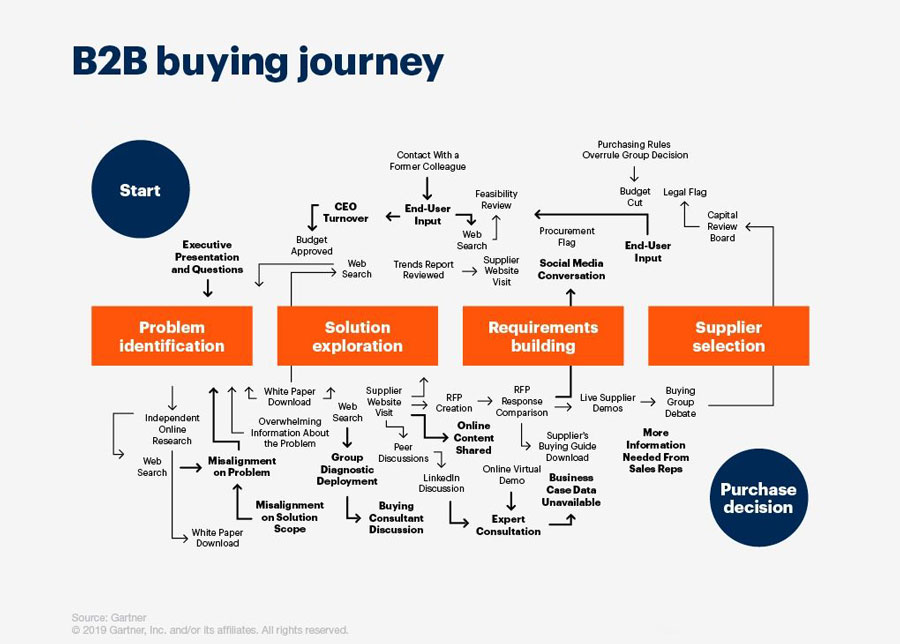
Normally, Any business that sells to other businesses and hopes to distinguish itself from the competition and retain clients should have a strong brand. However, creating a brand for these types of businesses is not the same as creating a brand for products that the average consumer purchases.
The key difference is that B2B brands build long relationships with other businesses, not shoppers. Company customers have complex needs requiring custom solutions. They also take a long time, months or years, before purchases.
That’s why a strong, consistent B2B brand strategy is crucial. It shows value, builds trust and credibility, and guides potential customers through the lengthy buying process. Without that, a B2B company will struggle to get good long-term partners.
Understanding B2B Branding
B2B means businesses sell products or services to other companies and groups rather than individual consumers. Every good B2B company has made a strong brand name and identity that makes them recognizable.
The core of B2B branding is creating and marketing a unique brand identity, which includes a company’s image, messaging, and interactions with its target audience through various channels, including websites, advertisements, events, and customer support interactions. It is essential to maintain a powerful and consistent branding strategy.
B2B branding allows a company to consistently communicate its unique value, skills, and experience to other organizations across all customer touchpoints. It shows potential partners what separates them from competitors. A cohesive brand identity signals professionalism, credibility, and trustworthiness to other businesses considering working with them.
So, while their target audience is other companies instead of consumers, smart B2B branding is crucial for long-term success. It’s the foundation for marketing and sales to prospective business partners.
Executed well, it gets its name out there, attracts new opportunities, and cultivates lasting customer relationships over many years. Without it, even the most capable B2B company gets lost in the shuffle.
Why B2B Branding Matters
In the massive $18 trillion B2B market, having a memorable brand that businesses can trust gives you a huge competitive advantage. Purchases between companies tend to be complex decisions involving many people over time. A strong brand helps in several big ways:
Build Credibility and Trust
Before partnering up, B2B buyers need to feel confident that your company truly understands their needs and can deliver on what you promise. Consistent, professional branding reinforces your expertise.
Differentiate from Competitors
In the same market, there are usually lots of B2B companies competing with each other. Having a strong brand helps you stand out and tells customers what makes you special compared to other options.
Forge Lasting Business Relationships
Unlike one-time buyers, B2B companies aim to develop enduring client relationships. A brand that organizations feel tied to encourages steadfast loyalty over the long haul. When businesses emotionally connect with a supplier’s brand, they remain customers for years through ups and downs. This stable foundation allows both sides to weather changes and grow together.
Fuel Business Growth
Well-known brands make selling much easier at every stage—getting on buyers’ shortlists, closing bigger deals, and expanding into new markets or product lines.
Attract Top Talent
A company with a respected, well-defined brand has a much easier time recruiting and keeping the best professionals excited about the mission.
Behind the scenes, well-planned B2B branding also unifies the marketing and sales efforts across an entire organization. It provides a cohesive game plan to ensure everyone is aligned and working towards the same brand vision.
While the approach differs from that of consumer brands, investing time and effort into world-class B2B branding can pay off hugely. It becomes the foundation for all marketing, sales success, and long-term business growth when done right.
Key Elements of B2B Branding
Creating a strong B2B brand involves paying close attention to several important aspects that shape identity, reputation, consistency, and customer experience. Let’s take a closer look at each of these key areas:
Brand Identity
Your identity covers the visible things that make your brand uniquely recognizable – like your company name, logo design, color selection, fonts, and other visuals. It’s the first tangible expression of your brand that customers interact with.
A strong, distinctive brand identity is important for standing out in B2B markets. It creates that crucial first impression and signals customers what to expect from your brand’s personality. Is your vibe modern and innovative or more traditional and established? Fun and approachable or professional and trustworthy? Your identity shapes these critical brand perceptions right from the start.
Brand Reputation
While identity is the outward face of your brand, reputation is how customers perceive and feel about your brand based on their experiences over time. Brand reputation covers the collective public opinion about your company’s quality, credibility, customer service, workplace values, social responsibility efforts, and more.
In B2B, reputation is everything. Before partnering, businesses want confidence that you’ll deliver on your promised value without risking damage to their reputation. A strong brand reputation built on proven expertise and trustworthiness is key to winning over buyers with long sales cycles.
Brand Consistency
Consistency ties your whole brand together and creates unified experiences for customers no matter how they engage with your business. It means showing your identity and promised value through a continuous look, voice, and persona across all channels – website, marketing, sales, product/service delivery, customer support, and more.
Maintaining brand consistency is crucial and challenging for B2B brands working across many teams, regions, and industries. However, it allows customers to recognize your brand and know what to expect instantly. Inconsistency leads to brand confusion. Strong consistency is important for any business wanting good long-term company partners.
Brand Experience
Ultimately, your customer experience solidifies their lasting perception of your B2B brand. Are you living up to your promised brand identity and value? Or is there a gap between what you claim to be and how customers experience your brand?
Every interaction a consumer has with your company, whether through marketing efforts, using your product or service, or contacting customer support, influences their entire brand experience. Making sure this experience is consistently great in every interaction is how you earn strong customer loyalty, get people to advocate for your brand, and stand out from your competitors.
Strategies for Effective B2B Branding
Building a strong B2B brand requires a comprehensive, multi-faceted strategy promoting visibility, credibility, and lasting connections with your target businesses. Here are some proven tactics to amplify your branding efforts:
Content Marketing
Making high-quality educational materials to position yourself as an industry leader and gain people’s trust is essential in B2B branding. A successful content marketing plan employs formats such as:
- Blogs/Articles: Share insights, thought leadership pieces, and advice addressing common pain points and industry trends. This content builds brand awareness and authority.
- Whitepapers/Guides: Offer in-depth, data-backed resources that thoroughly explore specific topics and solutions relevant to your audience’s needs.
- Case Studies: Case studies showing real products used by actual clients demonstrate value and results businesses want.
- Videos: Videos like tutorials, interviews, webinars, and series help make a brand feel relatable.
The goal is to inform and interest prospects at each stage before and during a purchase.
Search Engine Optimization (SEO)
For B2B brands, having an optimized online presence is the bare minimum. Your ideal business customers are searching for solutions online, so your website, content, and other digital touchpoints must appear and rank well in search results.
On-page SEO best practices include optimizing page titles, meta descriptions, headers, image tags, and other website code with relevant industry keywords. Additionally, producing high-quality content around those target keywords and earning authoritative backlinks all help improve your visibility and search rankings.
The better optimized you are, the more likely potential customers searching for products or services like yours will find and engage with your B2B brand online.
Social Media Marketing
While social media is usually for customers, having an active strategic LinkedIn, Twitter, and Facebook presence provides value for B2B, too. Share content, follow discussions, interact with potential customers, and generate sales leads through paid ads focused on key accounts.
The most effective B2B social brands foster two-way conversation and engagement. They share expertise, join relevant discussions, respond promptly, and prioritize developing real relationships over constantly selling.
Customer Testimonials
In B2B, where purchases are big bets, hearing from respected clients lending support means a lot. Testimonials show how solutions worked out for peer companies that took the chance. Success stories put value and the ability to transform businesses front of mind. By intelligently combining information with success stories, a trustworthy brand is promoted, attracting long-term partners.
The most compelling testimonials share specifics, such as the challenges faced, tangible results achieved, numerical metrics, and an enthusiastic willingness to recommend your brand.
Case Studies
Related to testimonials, well-crafted case studies allow you to delve deeper into successful customer stories. Effective B2B case studies cover:
- The client’s initial challenges, pain points, and objectives.
- Why did they choose your brand over alternatives?
- The specific solutions/services implemented.
- How your expertise and approach made a difference.
- Quantified results, ROI metrics, or other success benchmarks.
- A statement on continued partnership.
When executed properly, case studies serve as engaging success stories highlighting your brand’s value proposition and capacity to deliver transformative results for businesses.
Companies looking to elevate their B2B branding across multiple touchpoints can leverage Dream Farm Agency’s full branding and marketing services suite. From brand development and Marketing Strategies to crafting distinctive Brand Design elements and immersive Interactive Brand Experiences, Dream Farm provides expert guidance. Our solutions also encompass Digital Marketing, Creative Content Production, Brand Mascot development, Web3/Metaverse branding strategies, and animation studio capabilities – geared to strengthen B2B brand identities and foster more meaningful customer connections.
Challenges in B2B Branding
As consumer brands do, B2B marketing involves selling to companies, not people. Because of this, B2B companies face unique obstacles when promoting to organizations. Let’s look at some frequent problems and how to address them.
Reaching the Right Decision Makers
In B2B, many people make purchases that affect their company together. Getting your brand’s message to the right stakeholders, who each see risks and rewards differently, is tough.
To overcome this, do thorough research to understand your target audience profiles – their roles, pain points, and what’s important in their buying process. Then, strategically promote your brand across the channels and platforms where these key players are actively engaged.
Complex Buying Cycles
Unlike shoppers’ quick choices, B2B sales take longer and require many steps. Keeping your name relevant throughout the process, from awareness to deal, is challenging.
The decision journey in B2B businesses varies greatly depending on the type of product and the target businesses. For example, in the infographic below, you can see that there are four main stages. In each stage, different individuals or teams are involved in the decision-making process, and there may be multiple meetings held throughout the process.
In the following, we will examine this example.

Differentiation in Crowded Markets
In crowded B2B fields, how do you distinguish yourself, and how do your solutions improve problems more than rivals’? Conducting thorough research helps discover your unique strengths, allowing you to consistently communicate your message.
there is two strategy about Differentiation:
- Creating a Sustainable Advantage:
- David A. Aaker discusses the importance of differentiation by creating a sustainable competitive advantage that cannot be easily copied. Brands should focus on building unique capabilities and assets, continually evolving to maintain relevance in their market.
- Being the Opposite:
- Al Ries and Jack Trout emphasize that in a crowded market, it can be effective to position oneself as the opposite of the market leader. This strategy involves understanding the leader’s position and presenting your brand as the alternative, thus targeting customers who are looking for something different.
Both authors highlight the importance of differentiation but approach it from different angles: Aaker suggests building unique internal capabilities, while Ries and Trout recommend leveraging market positioning relative to competitors.
Building Trust and Credibility
High-risk B2B choices need tried-and-true brands proven to deliver. Rely on reviews, case studies, and authoritative content to showcase expertise and dependability.
Aligning Internal Teams
Cross-team cooperation from ads to sales to service impacts the brand experience customers receive. Make sure everyone shares the same brand values with clear communication. Address inconsistencies to strengthen your external perspective.
Measuring ROI
With long sales cycles and multiple touchpoints, quantifying the precise impact and return on your B2B branding investment can be extremely challenging. However, securing sufficient budget and resources depends on demonstrating real value.
Implement advanced analytics, unified data sources, and attribution modeling to connect branding activities to key metrics like leads, sales pipeline, customer lifetime value, and overall revenue impact where possible. Continuously optimize based on performance insights.
By being aware of these potential roadblocks and taking proactive steps to address them, B2B organizations can craft a brand strategy that breaks through the noise, builds lasting customer relationships, and sustainably fuels business growth.
Understanding the B2B Customer Journey
Along with tracking your brand, watch how customers move from first contact to purchase. This links branding activities to real business outcomes.
Some areas to monitor:
- Lead Sources: Where do potential customers first encounter and engage with your brand?
- Lead Quality: What percentage of leads fit your product/service well?
- Sales Cycle Length: How long does it take from the lead to the finalized deal?
- Customer Acquisition Cost: The total spend to gain each new customer.
- Customer Lifetime Value: Revenue a client brings over the whole relationship.
Understanding this journey can help you identify friction points, optimize touchpoints, and calculate objective return metrics.
Bringing It All Together
In the end, the aim of your B2B brand is to pursue durable revenue gains over time. Checking branding equity and financial results lets you refine the approach for more success and return.
Keep in mind measurement continues over the long haul. Frequently review your important numbers, find areas to strengthen, experiment with new tactics, and consistently make adjustments. With time and the right information, you’ll understand exactly how much your branding efforts contribute. Regular review of what’s working and what needs improvement ensures business growth.
Case Studies
Understanding how successful brands approach their B2B branding can provide valuable insights and inspiration for your strategy. Let’s explore a few real examples highlighting world-class B2B branding in action.
Salesforce
Salesforce is a prime example of a B2B company that has built an extremely powerful global brand identity. Their focus on cloud solutions has allowed them to stand out and position Salesforce as the trusted leader in customer relationship management (CRM) software and services.
Through innovative products, visionary leadership, and commitment to delivering value, Salesforce has cultivated a brand perceived as reliable, cutting-edge, and great at solving complex business challenges. Their famous annual Dreamforce conference and widespread industry recognition reinforce this prestigious positioning.
The success? Salesforce’s brand power has fueled incredible growth, reaching over $21 billion in revenue while attracting over 150,000 companies as customers across virtually every industry.
Mailchimp
In the crowded email field, Mailchimp stands out with a bold, inventive identity. Unique visuals, quirky tone, and people-focused framing make them memorable versus boring corporate brands.
By exuding fun, friendliness, and approachability rather than stuffiness, Mailchimp connects with companies of any size while making emails feel simple and manageable.

Mailchimp consistently delivers on its brand promise, from its website to its products to educational content and customer support. This authenticity has cultivated intense loyalty, allowing it to attract over 14 million customers.
HubSpot
HubSpot exemplifies brand-building through leadership and know-how. As the pioneers behind inbound marketing methods, they’ve made themselves the go-to choice and advisors in transforming how businesses attract, engage, and please customers.
HubSpot’s consistent messaging across all channels reinforces this position. Plus, top resources and guiding the buyer journey deliver real value. Their marketing works as one to keep inbound processes in mind.

By living their brand’s inbound principles, HubSpot has rapidly grown to support over 114,000 customers in over 120 countries. Their powerful brand recognition even led to a successful $100 million IPO.
Drift
Drift is a marketing/sales company that utilizes conversational marketing to connect with businesses. Their brand focuses heavily on authenticity across all branding and marketing efforts.
Drift only uses real images of employees and customers on its website and social channels. All its content provides genuine, candid insights directly from executives. This transparent approach has allowed it to build immense trust and customer loyalty.
Their authentic, human-to-human branding strategy has resonated, helping Drift rapidly acquire over 50,000 customers in just 5 years since its founding.
As a provider of countless B2B solutions, Google presents an intriguing branding challenge spanning its diverse portfolio of cloud software, productivity tools, advertising platforms, cutting-edge tech, and more.
Google has mastered brand consistency through meticulous attention to visual details. Their iconic elements, like the multicolored logo, design styles, color palettes, typefaces, and more, maintain a cohesive, unified feel across every product and touchpoint.
This reinforces Google’s positioning as an end-to-end provider on which businesses can depend. Client testimonials underscore the value and reliability of their offerings.
The universality of the Google brand identity has undoubtedly fueled immense global adoption of their B2B technologies by companies worldwide.
Conclusion
In today’s competitive business environment, having a powerful, well-defined brand is no longer just a bonus – it’s fundamental for any B2B company wanting to stand out, build trust, and foster lasting ties with clients. Throughout this guide, we touched on the unique challenges and strategies of effective B2B branding. There’s much to consider, from crafting a distinct identity and positive reputation to ensuring consistency across client touchpoints and exceptional experiences.
In essence, B2B branding demands a comprehensive, customer-focused approach beyond logos or slogans. It centers on truly understanding your audience, sharing your special value, and continually showcasing expertise and reliability. By investing in brand strategy, you can set yourself apart from competitors, streamline marketing/sales, attract talent, and spur sustainable growth.
Ready to elevate your B2B brand and forge ahead of your competition? Connect with Dream Farm Agency today. Our team of experts is dedicated to crafting brands that resonate and achieve measurable results.
Sogand



